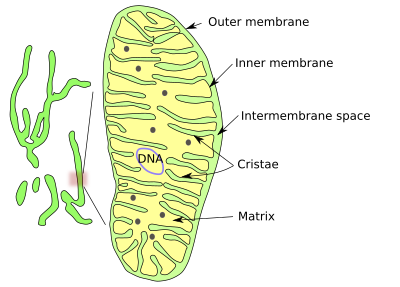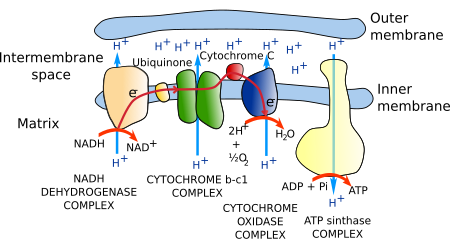Mmitochondria are almost ubiquitous organelles in eukaryotic cells. They are the result of an evolutionary process called endosymbiosis. The shape of mitochondria is variable, from long and branched to small ellipsoids. They can fuse with one another and split easily. It is difficult to know the total number of mitochondria within one cell because of this ability for fusion and fission. Mitochondria show an extraordinary motility through the cytoplasm, and they are usually found where more energy demand is needed.
1. Morphology
Mitochondria are made up of an outer membrane, an inner membrane, an intermembrane space and the mitochondrial matrix enclosed by the inner membrane (Figures 1 and 2).


The outer mitochondrial membrane is highly permeable. On the other hand, the inner mitochondrial membrane is highly impermeable to ions and small molecules and is heavily folded with invaginations toward the matrix. Each fold is called a mitochondrial crista (cristae in plural).
DNA, ribosomes, and many enzymes are located in the mitochondrial matrix, where several metabolic pathways take place. The mitochondrial DNA is found in places referred to as nucleoids, which may contain more than one DNA molecule. DNA contains around 37 genes that, in humans, code for 13 proteins. There are many other proteins in the mitchondria coded by the nuclear genes and imported into the mitochondria from the cytosol.
2. Functions
Power plants
The fuel for most cellular processes is ATP, which is mostly synthesized in the mitochondria (in non-photosynthesizing eukaryotes). The process is based on a chain of proteins referred to as the electron transport chain, which generates a proton gradient across the cristae membrane, and on the ATP synthase that uses this gradient to synthesize ATP. The overall system of reactions is called oxidative phosphorylation because it consumes oxygen (Figure 3).

Cellular stress
Mitochondria are essential organelles for the cell, so any flaw in their functioning is potentially dangerous. Cellular stress responses are initiated when mitochondria are stressed, which include the removing of malfunctioning mitochondria by macroautophagy (mitophagy). Meanwhile, mitochondria try to get repaired by a local repairing mechanism called UPRMT (unfolded protein response). However, if the stress is long-lasting and mitochondria cannot be recovered, a regulated cell death program known as apoptosis is initiated, and mitochondria play a key role in triggering apoptosis.
Others
A significant amount of cell lipid metabolism (for instance, beta oxidation) takes place in mitochondria. They also store calcium and synthesize heme groups, amino acids and iron-sulfur groups. Nowadays, mitochondria are thought to be involved in cancer, aging and neurodegenerative diseases like Parkinson's and Alzheimer's, as well as in the innate immune response. Furthermore, the comparative studies of mitochondrial DNA are a major technique for phylogenetic studies and anthropology, since mitochondria are only maternally inherited and do not recombine their DNA during sexual reproduction.
-
Bibliography ↷
-
Friedman JR, Nunnari J. 2014. Mitochondrial form and fucntions. Nature. 505: 335-343.
Kiefel BR, Gilson PR, Beech PL. 2006. Cell biology of mitochondrial dynamics. International review of cytology. 254: 151-213.
MacAskill AF, Kittler JT. 2010. Control of mitochondrial transport and localization in neurons. Trends in cell biology. 20: 102-112.
Pickles S, Vigi P, Youle RJ. 2018. Mitophagy and quality control mechanisms in mitochondrial maintenance. Current biology. 28: R160-R185.
-
 Peroxisomes
Peroxisomes